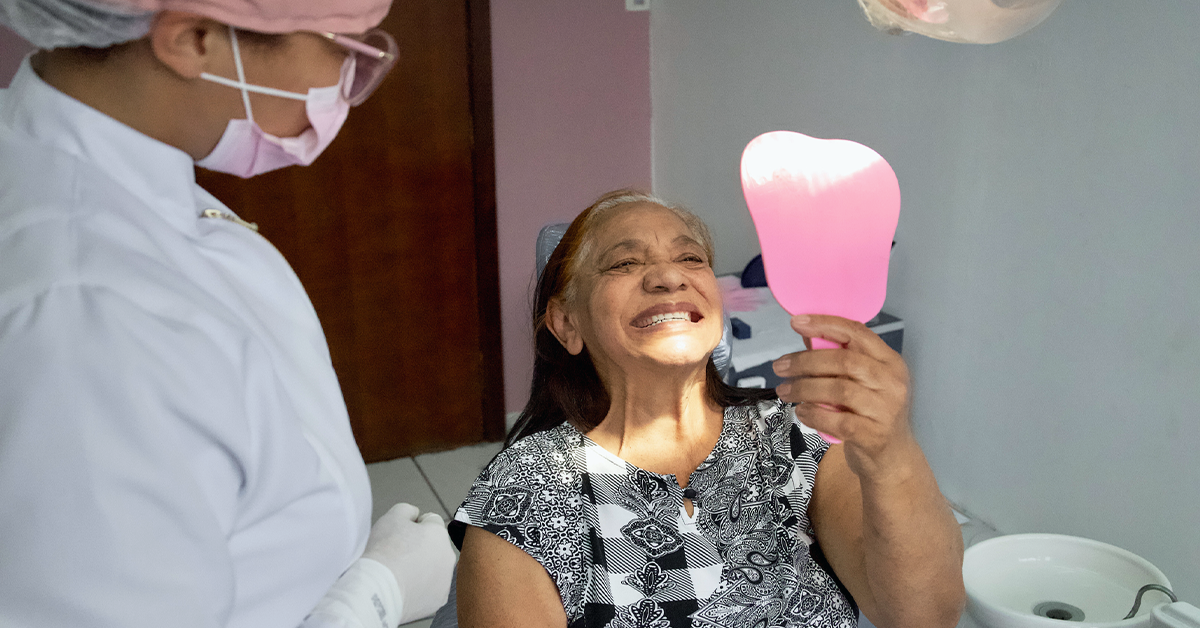What generation do you think of when you hear the term: “Best Generation?” I don’t know about you, but immediately I think of the senior community. Sure, the best is yet to come, but our elders teach us how to appreciate life and the many opportunities within it. Their golden nuggets of wisdom give us binoculars to prepare for what is ahead and to avoid the pitfalls along the way. Thankfully the senior community is growing rapidly. There will be enough wisdom to sustain us all. According to Administration for Community Living, in 2019, there were 54.1 million people over the age of 65. The aging population is expected to reach 80.8 million by 2040 and 94.7 million by 20601. This is a generation that cannot be overlooked!
Many baby boomers are living robust lives. They are working longer and living better. They are healthier with a better quality of life and are retaining their natural teeth. Isn’t this great news? With the retention of natural teeth in older adults, dental professionals need to continue to progress to meet the demands that an older population presents. The old myth: “As people age, they lose their teeth” is unfactual in 2022. Since old myths like this are perceived culturally, there is a major gap in oral healthcare. Many of our elders suffer from oral neglect and a lack of training. I charge all senior healthcare providers to become competent in rectifying the neglect. When seniors’ oral health is neglected, it can cause digestive issues, pain from unnatural tooth loss, and difficulties in speaking, chewing and swallowing. Let me ask you a question: What if you suddenly found it painful and hard to speak, chew, and swallow? How would you find it difficult to enjoy life? Regrettably, that is a reality for millions of older adults around the world.
Most nursing home staff in long-term care facilities do not know how to properly clean dentures. In some cases, long-term caregivers find it challenging to thoroughly and gently brush natural teeth for someone else. These incompetencies contribute to the overall problem that we are discussing today—Periodontal disease. According to the Centers for Disease Control and Prevention (CDC), forty-two percent of adults have gum disease. Among adults aged 65 and older, the rate of gum disease increases by 60%.2 Gum disease and several other factors contribute to the fact that adults aged 65 and older have the highest incidence of periodontal disease in the United States. In addition, the prevalence of periodontitis is significantly higher in 70–81-year-old compared with those 50-59 years old.
Periodontal disease within the senior community
If you are unfamiliar with the term periodontal disease, allow me to enlighten you. Periodontal disease is a chronic inflammatory disease of periodontium, and its advanced form is characterized by periodontal ligament loss and destruction of surrounding alveolar bone3. It is one of the main causes of tooth loss and is considered one of the biggest threats to oral health, with nearly half of US adults exhibiting some form of periodontal disease4. As the incidents of periodontal disease increase with age, some might wonder: Why should we try to retain natural teeth with active periodontitis? Instead of replacing them with dental implants. Part of the answer lies in the fact that peri-implantitis shares the same risk factors as periodontitis. Patients with active periodontitis and even stabilized periodontium have an increased prevalence of peri-implantitis5-6. I have seen numerous failed implants in the mouths of frail older adults. I have witnessed many patients suffering from painful and infected implant abutment. It is difficult to find a dentist that will remove the implant on medically compromised patients that live in a long-term care facility. When considering placing oral implants in older adults, the quality of life should always be considered.
Periodontal treatment plans
As dental professionals, it is time to consider periodontal treatment plans for aging adults. Periodontal treatment plans are always based on the patient and their needs. For instance, the aging adult that is functionally independent and mobile is capable of visiting the dental office regularly will have a different treatment plan than the patient that lives in a long-term assisted living facility. As a dental hygienist of over 30 years, I would suggest the following periodontal treatment plan for the independent patient that is still fully mobile: First, I would complete a medical history review—taking into consideration disease conditions that could affect the patient’s oral health. Disease conditions like uncontrolled diabetes, uncontrolled hypertension, and other systemic conditions could affect wound healing. Secondly, there must be a thorough medication review as some medications adversely impact oral care and treatment. Medications like blood thinners and cancer treatment are some of the most harmful medications when creating a periodontal treatment plan.
As with any other patient, home care instructions is the key to continued success. It is important to consider dexterity and disabilities when recommending home care products for Seniors.
Sonya Dunbar
It is important to explain the plan and expectations to the patient making sure they fully understand the treatment and expected outcome. Following the explanation of the treatment plan is the third step which is to obtain the patient’s consent and signature for the suggested plan. The fourth step would be to conduct a comprehensive periodontal exam. The last steps within an effective periodontal treatment plan involve treating debridement scaling, root planing, and placement of local or systemic pharmacological therapy with a 4-week re-elevation. As with any other patient, home care instructions is the key to continued success. It is important to consider dexterity and disabilities when recommending home care products for older adults. In 2019, 24.1% of adults 65 to 74 and 47.1% of adults ages seventy-five and older reported having a disability including cognitive, visual, auditory, ambulatory, self-care, and independent living.7
Product recommendations for seniors with periodontal disease
I recommend Patterson Dental products because they have cost-effective and useful products for older adults. Cost should always be considered because many older people are retired and have fixed incomes. Oral-B Sensitive GumCare electric toothbrush is a great recommendation for older adults with sensitive gums, and the Waterpik cordless advanced water flosser is also a great recommendation because of the large handle. It is user-friendly, especially for those seniors with arthritis.
The big picture
The moral of the story is that periodontal treatment planning for the patient that lives in a long-term care facility is slightly different than the mobile patient. Sure, as the oral care provider you will follow the same protocol for reviewing their health history and medications. However, when obtaining consent and a signature, you may have to call the family or responsible party if the patient is cognitively impaired. Before beginning any form of periodontal treatment, five components should be taken into consideration5:
- The patient’s ability to tolerate treatment
- The probability of a positive outcome
- The Impact on the Patient’s Quality of Life
- The patient’s Capability to maintain their oral health
- The capabilities of the oral health professionals
When providing non-surgical periodontal treatment for a patient in long-term care, it must be a team effort educating the staff, patient and family on expectations is key. Everyone deserves a quality of life and an opportunity to oral health care regardless of their age!
Fighting periodontal disease
Most of the luxuries that we enjoy today are due to our elders. We pursue a better quality of life and overall health care for our elders because we owe them that much. Their sacrifices are our privileges. We should all do our part in eliminating periodontal disease and other preventable oral diseases within the senior community! We are called to train and educate ourselves and our colleagues as dental professionals. As patients, we are to bring awareness to our friends and family and lead by example. It all starts with your oral health. We can only teach what we do. Join us in fighting periodontal disease by tending to your oral health and holding others accountable to do the same.
References
- Projected Future Growth of Older Population. U.S. Department of Health and Human Services, Administration for Community Living. 2019.
- Disparities in Oral Health. Centers for Disease Control and Prevention. 2022.
- Muhammad Ashraf Nazir. Prevalence of periodontal disease, its association with systemic diseases and prevention. Int J Health Sci (Qassim). 2017 Apr-Jun; 11(2): 72–80.
- Eke PI, Dye BA, Wei L, Thornton-Evans GO, Genco RJ. Prevalence of periodontitis in adults in the United States: 2009 and 2010. J Dent Res. 2012;91:914–920.
- Sivaraman Prakasam, BDS, MSD, PhD. Periodontal Care for Older Adults. Dimensions of Dental Hygiene. July 2015;13(7):45–50.
- King E, Patel R, Patel A, Addy L. Should implants be considered for patients with periodontal disease? Br Dent J. 2016 Dec 9;221(11):705-711. doi: 10.1038/sj.bdj.2016.905. PMID: 27932832.
- Public Health Impact: Able-bodied. United Health Foundation. 2022.
About the author
Sonya Dunbar is a speaker, educator, author and trainer on the importance of oral health care, focusing on the geriatric population. Sonya has more than 25 years of dental experience in private practice, skilled nursing facilities, academia and marketing, and is the founder or co-founder of several oral health care organizations including the Geriatric Toothfairy, Mobile Dental Xpress, the National Mobile Dentistry Conference and the American Mobile Dentistry Alliance.
– – –



